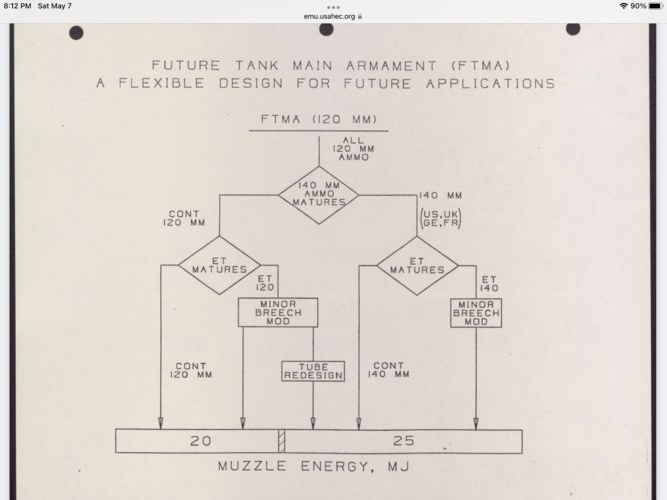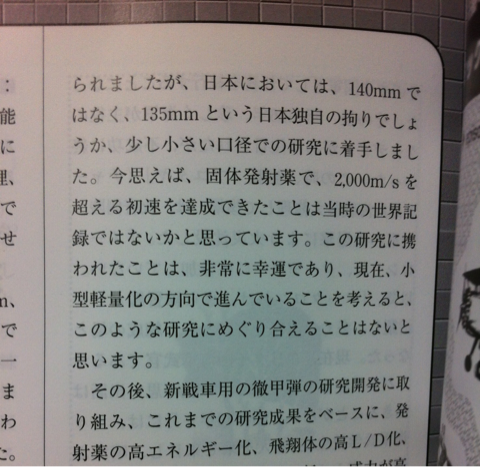Considering the actual 140mm FTMA never got off the ground, I don't see a 140mm ETC going anywhere either.
The experimental 140 was test fired. An ETC version was in the planning.
The weak performance of ETC in practice versus the make-believe theoretical performance would have killed an ETC FTMA all the same?
ETC is a dead end technology. It just took developing it in 120mm instead of 140mm to figure it out. So now we're back to developing a 130-152mm class gun instead. If 140mm FTMA got off the ground, it would have just remained a conventional gun because ETC is not a contender for any future gun, and focus would shift to probably making 140mm a single piece ammo instead of two piece, to have longer LRPs.
140mm's weakest link was the penetrator length limit brought about by two piece ammo, similar to the 2A82 and the L30, in reality.
It would have been slightly longer than the current Rheinmetall 130mm and possibly the same caliber, or larger, like 152mm.
Where do you get this information about ETC being a supposed dead-end?
The fact that M8 Lightning Bolt fired enough rounds for people to figure out the only measurable gains to be had were slightly more consistent pressure curves given a wider range of ambient temperatures.
If you think ETC isn't dead I suggest you approach Rheinmetall and tell them about it. They'll be very interested in hearing from you considering they and United Defense did substantial work on the subject a mere 20 years ago (which might as well be 20 minutes in tank technology time) and discerned that a larger caliber gun was the only viable method of improving muzzle energy of a given penetrator.
Otherwise the issue is two fold: pressure can't be ramped up enough with merely adding newer hotter propellants and more consistent detonation of propellant in the barrel isn't the actual issue. We're at the point that a 85,000 psi gun can't easily get much more pressure into it without building an entirely new gun because the case is maxed out, and at that point you might as well consider a new lot of ammunition to boot, not the least to keep the pressure at 85,000 psi instead of trying to make it even hotter.
105mm was completely tapped out after 50 years too. So has 120mm now. I'd expect to see 130mm tapped out sometime around 2070 and a new gun show up in 2090 if there are tank engineers still around to make them.
I don't see a switch to a high velocity 152mm or similar caliber as offering very much here. Carrying enough 130mm or 140mm shells will be a challenge going larger just makes that problem worse.
Yes this is accurate. Tanks no longer fight each other. They now fight houses and machine guns in support of light infantry.
Tradition: returned.
Tanks stopped consuming large quantities of ammunition in the 1980's because the primary driver of ammunition, bracketing, disappeared with modern fire control systems. Even 20 rounds seems a bit excessive these days, given the paucity of tank engagements, and 30 rounds was more than enough in 1991 for the largest armored battle since Kursk.
Conversely, machine gun ammo seems to never be in enough supply.
Future tanks with a dozen and a half rounds of 152mm of two natures (GP and sabot) and 20-30,000 rounds of machine gun ammo would probably be in adequate supply of both types of ammunition tbh. Not that that would happen, mostly since 120mm is perfectly fine for the moment, but it would be closer to the mark for actual ammo consumption over the past two or three or so generations of American soldiers.
Or we might see a return of female and male (sorry, infantry support and mobile gun) tanks (systems). Well we already see that, but more explicitly I guess. An Puma-esque IFV carrying a 120mm gun with a 10-20 rounds in a bustle loader and like 30,000 rounds of machine gun ammo for three separate .30 cal turret-blisters is probably a more and better tank for actual use in real wars than a M1 Abrams or Leo 2 with a 130mm tbh. Rafael's Carmel is shaping up to be that way, and is even platform agnostic at the end, so it can probably have systems retrofitted to older and less modern vehicles like Merkava IV.



